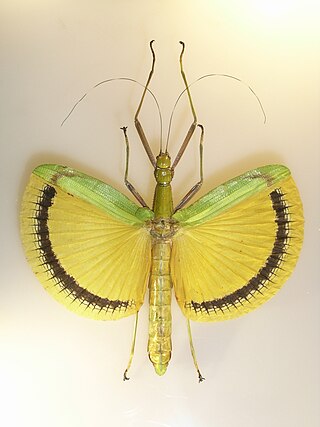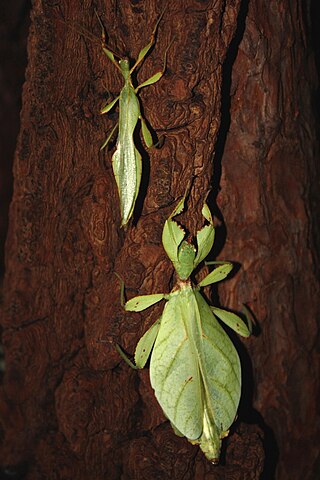
The family Phylliidae contains the extant true leaf insects or walking leaves, which include some of the most remarkably camouflaged leaf mimics (mimesis) in the entire animal kingdom. They occur from South Asia through Southeast Asia to Australia. Earlier sources treat Phylliidae as a much larger taxon, containing genera in what are presently considered to be several different families.

Phobaeticus serratipes is a species of stick insect that at one time was the longest known insect, with one female specimen recorded as being 55.5 cm (21.9 in) in total length. This measurement includes the legs fully extended front and rear, and the actual length of the body alone is considerably shorter. This insect is endemic to Peninsular Malaysia, Singapore and Sumatra. It is a popular species among those who raise insects.

The Phasmatidae are a family of the stick insects. They belong to the superfamily Anareolatae of suborder Verophasmatodea.

Necrosciinae is a subfamily of the stick insect family Lonchodidae, with its greatest diversity in South-East Asia.
Phobaeticus chani, the Chan's megastick, is a species of stick insect in the tribe Pharnaciini, native to the southeast Asian island of Borneo. It is one of the longest insects in the world and was once considered the record-holder. One specimen held in the Natural History Museum in London measures 56.7 cm (22.3 in). This measurement is, however, with the front legs fully extended. The body alone still measures an impressive 35.7 cm (35.7 cm).
Asceles is a genus of stick insects in the tribe Necrosciini. Some of the species of Asceles have a distribution in Malaysia and Singapore.

Pulchriphyllium giganteum, commonly known as the Giant Malaysian Leaf insect, is a species of leaf insects described from Malaysia by Hausleithner in 1984 and placed in the genus Pulchriphyllium since 2021. Pulchriphyllium giganteum is the largest species belonging to the genus Pulchriphyllium reaching 105 mm in size. They are found most abundantly in the west Malaysian tropics. The females typically have large elytra that lie edge to edge on the abdomen and tend to lack hind wings making them usually flightless. Males have small elytra and sometimes transparent non-leaflike functional hind wings. Pulchriphyllium giganteum found in the wild tend to be mostly females and the first male of this species was not found until 1994. In captivity, the species has primarily been observed to reproduce through parthenogenesis meaning the females are asexual. The primary reproductive pattern in the wild is unknown. Eggs tend to be brown or black and glossy and resemble seeds. They hatch around 6 months after breeding. Newly hatched young nymphs tend to be wingless and brown or reddish in color. They develop their green color after feeding on leaves. Both the adult and larval stages are phytophagous meaning they feed on plants. The main plant food sources for this species are oak and bramble tree leaves.

Pulchriphyllium bioculatum, Seychelles leaf insect, Javanese leaf insect, or Gray's leaf insect, is a leaf insect of the family Phylliidae native to tropical Asia as well as Madagascar, Mauritius and the Seychelles. It was first described by George Robert Gray in 1832 and was the first phasmid he discovered. Leaf insects have extremely flattened, irregularly shaped bodies, wings, and legs. They are usually about 5–10 cm long. They are called leaf insects because their large, leathery forewings have veins that look similar to the veins on the particular type of leaves they inhabit. Its scientific name bioculatum means "two-eyed" and refers to the two dots located on the abdomen just in this species.
Abrosoma nebulosum is a species of phasmid or stick insect of the genus Abrosoma. It is found in Sri Lanka.
Lopaphus srilankensis, is a species of phasmid or stick insect of the genus Lopaphus. It is found in Sri Lanka. Two subspecies documented. It was first found from Anuradhapura.
Paraprisomera taprobanae, is a species of phasmid or stick insect of the genus Paraprisomera. It is found in Sri Lanka.
Parasosibia ceylonica is a species of phasmid or stick insect of the genus Parasosibia. It is found in Sri Lanka.
Sipyloidea ceylonica is a species of phasmid or stick insect of the genus Sipyloidea. It is found in Sri Lanka.
Ramulus braggi, is a species of phasmid or stick insect. It is found in Sri Lanka.
Ramulus lobulatus is a species of phasmid or stick insect. It is found in Sri Lanka.

Phyllium hausleithneri or Hausleithner's stick insect is a species of phasmid or leaf insect of the genus Phyllium. It is found in peninsular Malaysia, and Sri Lanka.

Phyllium jacobsoni is a species of leaf insect belonging to the family Phylliidae. Its recorded distribution is Java and no subspecies are listed in the Catalogue of Life.

Cryptophyllium westwoodii is a species of leaf insect in the family Phylliidae. It is distributed from southern China, the Andaman islands, Myanmar, Indo-China, Sumatra and the Riouw Archipelago.

The Lonchodinae are a subfamily of stick insects in the family Lonchodidae found in: Australasia, Asia, Africa, Southern America and the Pacific.
Paraprisomera is a genus of phasmids belonging to the family Lonchodidae.










